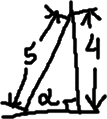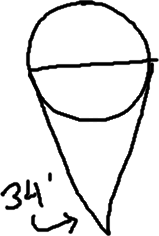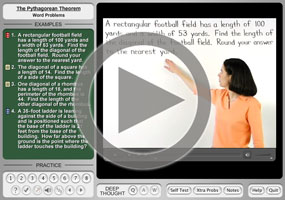Right-Triangle Word Problems
Purplemath
What is a right-triangle word problem?
A right-triangle word problem is one in which you are given a situation (like measuring something's height) that can be modelled by a right triangle. You will draw the triangle, label it, and then solve it; finally, you interpret this solution within the context of the original exercise.
Content Continues Below
Once you've learned about trigonometric ratios (and their inverses), you can solve triangles. Naturally, many of these triangles will be presented in the context of word problems. A good first step, after reading the entire exercise, is to draw a right triangle and try to figure out how to label it. Once you've got a helpful diagram, the math is usually pretty straightforward.
- A six-meter-long ladder leans against a building. If the ladder makes an angle of 60° with the ground, how far up the wall does the ladder reach? How far from the wall is the base of the ladder? Round your answers to two decimal places, as needed.
First, I'll draw a picture. It doesn't have to be good or to scale; it just needs to be clear enough that I can keep track of what I'm doing. My picture is:

To figure out how high up the wall the top of the ladder is, I need to find the height h of my triangle.
Affiliate
Since they've given me an angle measure and "opposite" and the hypotenuse for this angle, I'll use the sine ratio for finding the height:
Plugging this into my calculator, I get an approximate value of 5.196152423, which I'll need to remember to round when I give my final answer.
For the base, I'll use the cosine ratio:
6×cos(60°) = b = 3
Nice! The answer is a whole number; no radicals involved. I won't need to round this value when I give my final answer. Checking the original exercise, I see that the units are "meters", so I'll include this unit on my numerical answers:
ladder top height: about 5.20m
ladder base distance: 3m
Note: Unless you are told to give your answer in decimal form, or to round, or in some other way not to give an "exact" answer, you should probably assume that the "exact" form is what they're wanting. For instance, if they hadn't told me to round my numbers in the exercise above, my value for the height would have been the value with the radical.
- A five-meter-long ladder leans against a wall, with the top of the ladder being four meters above the ground. What is the approximate angle that the ladder makes with the ground? Round to the nearest whole degree.
As usual, I'll start with a picture, using "alpha" to stand for the base angle:

They've given me the "opposite" and the hypotenuse, and asked me for the angle value. For this, I'll need to use inverse trig ratios.
(Remember that m(α) means "the measure of the angle α".)
So I've got a value for the measure of the base angle. Checking the original exercise, I see that I am supposed to round to the nearest whole degree, so my answer is:
base angle: 53°
Content Continues Below
- You use a transit to measure the angle of the sun in the sky; the sun fills 34' of arc. Assuming the sun is 92,919,800 miles away, find the diameter of the sun. Round your answer to the nearest whole mile.
First, I'll draw a picture, labelling the angle on the Earth as being 34 minutes, where minutes are one-sixtieth of a degree. My drawing is *not* to scale!:

Advertisement
Hmm... This "ice-cream cone" picture doesn't give me much to work with, and there's no right triangle.
The two lines along the side of my triangle measure the lines of sight from Earth to the sides of the Sun. What if I add another line, being the direct line from Earth to the center of the Sun?
Now that I've got this added line, I have a right triangle — two right triangles, actually — but I only need one. I'll use the triangle on the right.

(The angle measure, "thirty-four arc minutes", is equal to 34/60 degrees. Dividing this in half is how I got 17/60 of a degree for the smaller angle.)
I need to find the width of the Sun. That width will be twice the base of one of the right triangles. With respect to my angle, they've given me the "adjacent" and have asked for the "opposite", so I'll use the tangent ratio:
This is just half the width; carrying the calculations in my calculator (to minimize round-off error), I get a value of 919002.8129. This is higher than the actual diameter, which is closer to 864,900 miles, but this value will suffice for the purposes of this exercise.
diameter: about 919,003 miles
- A private plane flies 1.3 hours at 110 mph on a bearing of 40°. Then it turns and continues another 1.5 hours at the same speed, but on a bearing of 130°. At the end of this time, how far is the plane from its starting point? What is its bearing from that starting point? Round your answers to whole numbers.
Affiliate
The bearings tell me the angles from "due north", in a clockwise direction. Since 130 − 40 = 90, these two bearings create a right angle where the plane turns. From the times and rates, I can find the distances travelled in each part of the trip:
1.3 × 110 = 143
1.5 × 110 = 165
Now that I have the lengths of the two legs, I can set up a triangle:

(The angle θ is the bearing, from the starting point, of the plane's location at the ending point of the exercise.)
I can find the distance between the starting and ending points by using the Pythagorean Theorem:
1432 + 1652 = c2
20449 + 27225 = c2
47674 = c2
c = 218.3437657...
The 165 is opposite the unknown angle, and the 143 is adjacent, so I'll use the inverse of the tangent ratio to find the angle's measure:
But this angle measure is not the "bearing" for which they've asked me, because the bearing is the angle with respect to due north. To get the measure they're wanting, I need to add back in the original forty-degree angle:
distance: 218 miles
bearing: 89°
Related: Another major class of right-triangle word problems you will likely encounter is angles of elevation and declination.
URL: https://www.purplemath.com/modules/rghtprob.htm
Select a Course Below
Standardized Test Prep
Homeschool Math
© 2024 Purplemath, Inc. All right reserved. Web Design by ![]()




